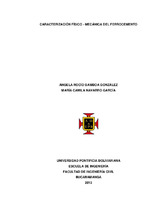Mostrar el registro sencillo del ítem
Caracterización Físico - Mecánica del Ferrocemento
| dc.contributor.advisor | Director. Torrado Gómez, Luz Marina | |
| dc.contributor.author | Gamboa González, Ángela Rocío | |
| dc.contributor.author | Navarro García, María Camila | |
| dc.coverage.temporal | 2013 | |
| dc.date.accessioned | 2020-09-14T21:49:00Z | |
| dc.date.available | 2020-09-14T21:49:00Z | |
| dc.date.issued | 2013 | |
| dc.identifier.uri | http://hdl.handle.net/20.500.11912/6010 | |
| dc.description | 93p.: (pdf); il; imágenes; gráficas; tablas; anexos. | spa |
| dc.description.abstract | En esta investigación se estudió el comportamiento de un material que tiene gran trayecto en la construcción pero no se emplea debido al desconocimiento de sus propiedades y al temor que se genera por sus bajos espesores (2.5 cros.). Este material recibe el nombre de ferrocemento y es concebido como el conjunto de mortero (ordinario o con aditivos) y malla de refuerzo. Para el proyecto se trabajó malla hexagonal, que es la más comercializada en Bucaramanga con diferente abertura (1/C y 3/4"). Para la caracterización del ferrocemento se construyeron especímenes que se adaptaron según la ACI 549, para ser sometidos a flexión, tracción y compresión. Estos ejemplares se fabricaron con diferente número de mallas, variando el volumen de fracción (contenido de acero) de estas secciones. Seguidamente se realizan los cálculos de resistencia teóricos consignados en la norma y se compara con los resultados experimentales, con el siguiente análisis: En Flexión se reportaron datos dispersos a nivel teórico, ya que se requerían parámetros que dependían directamente del proceso constructivo del ferrocemento. Para el análisis desarrollado a tracción, existe una diferencia de resultados entre los tipos de abertura trabajados, logrando mejores cuantías para la abertura de 3/4" que para la de W, debido a que esta última tiene más contenido de acero. Para las experiencias de flexión y tracción se aumenta la resistencia en función del número de capas de refuerzo, lo cual ocurre de forma inversa en los valores de resistencia a la compresión del ferrocemento, disminuyendo, según el aumento del volumen de fracción equivaliendo al 80% de la resistencia a compresión del mortero. Finalmente se revisa el comportamiento de las dos aberturas, y se concluye que es favorable emplear mallas con mayores aberturas porque representan un volumen de fracción moderado y son más fáciles de manejar en un proceso constructivo. | spa |
| dc.description.abstract | In this research was studied the behavior of a material that has a great ride in the construction area, but is not used due to unknowledge of its properties and the fear generated by its low thicknesses (2.5 cms). This material is called ferrocement and is conceived as a set of mortar (ordinary or with additives) and reinforcing mesh. For this investigation was worked an hexagonal mesh, which is the most marketed in Bucaramanga with different opening (W and %"). For the characterization of ferrocement were constructed specimens which were adapted according to AC1 549, to be submitted to bending, tension and compression. These samples were manufactured with different number of meshes varying the volume of fraction (steel content) of these sections. After that were performed theorical calculations of resistance recorded in the standard, and these values were compared with experimental results with the following analysis. The bending data reported a large dispersion on a theoretical level, as required parameters depending directly on the construction process. For the analysis done in a tension there is one difference between the worked opening type that obtained better results for the opening of %" than those of W because 'A" contains more steel. The results for the bending and tension research show an increase for the resistance on the function of number of reinforcing layers. Occurring on the inverse form for the compression resistance of ferrocement, decreasing according to the increase of the volume of fraction equal to 80% of the compression resistance of the mortar Finally, after reviewing the behavior of the two openings we concluded that is better to use the mesh with greater openings because gives a moderate volume of fraction and are better to use in a building process. | eng |
| dc.format.mimetype | application/pdf | |
| dc.language.iso | spa | |
| dc.publisher | Universidad Pontificia Bolivariana | spa |
| dc.rights | Attribution-NonCommercial-NoDerivatives 4.0 International | * |
| dc.rights.uri | http://creativecommons.org/licenses/by-nc-nd/4.0/ | * |
| dc.subject | Empresas - Argamasa S.A | spa |
| dc.subject | Hormigón armado | spa |
| dc.subject | Resistencia de materiales | spa |
| dc.subject | Flexibilidad | spa |
| dc.subject | Compactación | spa |
| dc.title | Caracterización Físico - Mecánica del Ferrocemento | spa |
| dc.type | Trabajo de grado | spa |
| dc.publisher.department | Escuela de Ingenierías | spa |
| dc.publisher.program | Ingeniería Civil | spa |
| dc.type.hasVersion | publishedVersion | spa |
| dc.description.sectional | Bucaramanga | spa |
| dc.description.degreename | Ingeniero Civil | spa |
Ficheros en el ítem
Este ítem aparece en la(s) siguiente(s) colección(ones)
-
Trabajos de grado [6688]
Monografías, artículos, informes, proyecto de grado


